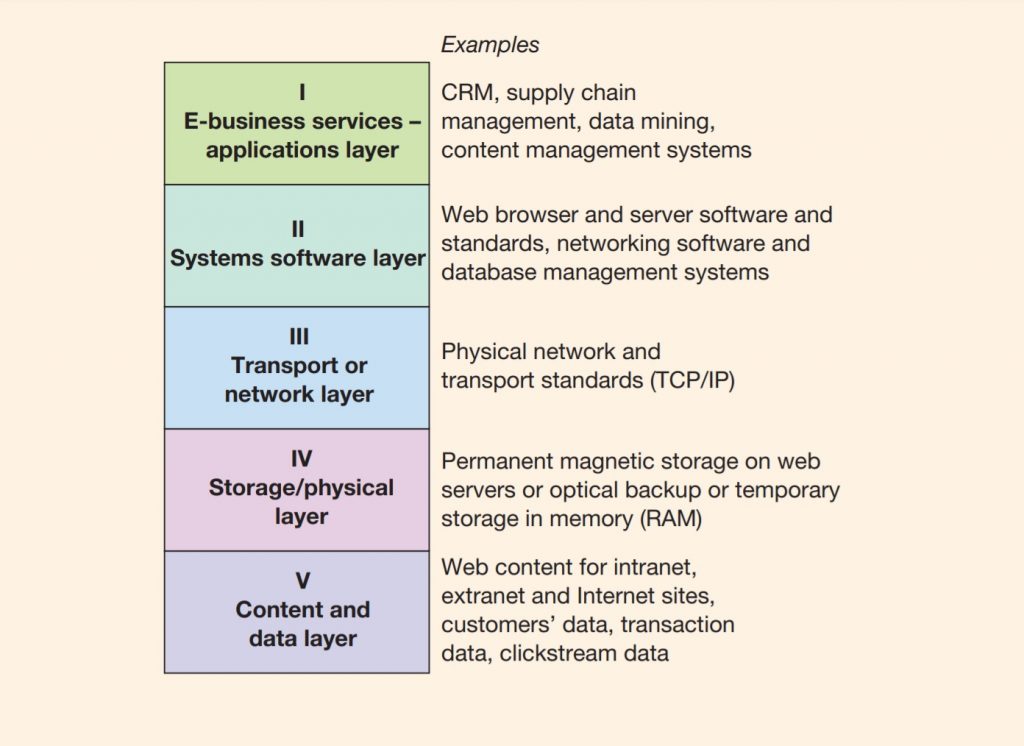eCommerce development could mean the fundamentals of eCommerce infrastructure, such as the Internet, extranets, and the World Wide Web, the standards used for electronic communications (TCP/IP, EDI), and publishing (HTML, XML), the hosting services offered by third parties, the potential of the best eCommerce platforms (mobile phones, interactive digital TV, etc.), and so on.
What Are the Fundamentals of eCommerce?

From the management’s point of view, when we talk about the fundamentals of eCommerce development, we can’t help but ask very high-level questions like, “What kind of e-commerce applications do we need to build (supply chain management, e-procurement, secure online ordering, or customer relationship management)?” Email, Web-based ordering, or Electronic Data Interchange (EDI)? Accordingly, we have to ask, where do we host eCommerce applications? Which access methods do we support (mobile access, digital TV with interactive features)? What tools and standards do we use for development? How do we publish content and data and keep track of their quality? How do we keep data safe? What is the creation process for an eCommerce site?
Such questions are relevant to experts in eCommerce development from an eCommerce development agency. We will only talk about the most important parts of a good e-commerce infrastructure in this article. Consequently, you should be able to talk to a third-party provider of hardware, software, and services using simple technical terms and ideas.
The Importance of an eCommerce Infrastructure
The importance of ecommerce infrastructure cannot be overstated. It’s the backbone that supports the entire operation of an online business. With ecommerce sales expected to grow 10.4% in 2023, and exceed 5.7 trillion U.S. dollars in retail purchases predicted to take place online, having a robust infrastructure is crucial.
A scalable ecommerce infrastructure allows your business to grow and adapt to increasing demands. It ensures your website can handle traffic surges, especially during peak sales periods. Without it, your website may underperform, leading to lost sales and dissatisfied customers.
Security is another critical aspect of ecommerce infrastructure. With the rise of cyber threats, having a secure infrastructure protects your business and your customers’ sensitive data. It builds customer trust and complies with regulatory requirements.
Moreover, an efficient ecommerce infrastructure supports seamless integration with other systems. This includes inventory management, customer relationship management (CRM), and payment gateways. Such integration streamlines operations, improves efficiency, and enhances the customer experience.
eCommerce Infrastructure Components
The hardware, software, content, and data used to provide e-business services to customers and business partners are all fundamental part of the eCommerce infrastructure. It has a direct effect on the speed and responsiveness of the service your customers get from you. We need to think of eCommerce infrastructure components as layers of infrastructure with clear points of connection between each layer. So, they should be thought about in terms of a typical task that a user of an e-business system would do.

The above graph presents the five fundamental layers of eCommerce infrastructure:
- E-business services – applications layer (i.e., CRM, supply chain management, data mining, content management systems)
- Systems software layer (Web browser and server software and standards, networking software and database management systems)
- Transport or network layer (Physical network and transport standards – TCP/IP).
- Storage/physical layer (permanent magnetic storage on web servers or optical backup or temporary storage in memory – RAM)
- Content and data layer (web content for extranet and Internet sites, customers’ data, transaction data, clickstream data)
In the following sections, we will go through the technologies that are popular in eCommerce development.
FURTHER READING: |
1. 10 Best eCommerce Website Design Services for Success |
2. What is B2B Ecommerce? All You Need to Know about B2B Ecommerce |
1. Internet Technology
Millions of computers around the world can talk to each other through the Internet. And because all data transfers on the Internet work through the request-response system between client computers or mobile devices and server computers, we can say that the Internet is a large-scale client/server system.

Most of the time, your customers’ computers connect to the Internet through local Internet service providers (ISPs). These ISPs are linked to larger ISPs, which are connected to the major national and international backbones, which are run by companies like AT&T, UUNET, and Verizon.
1. Hosting of eCommerce websites
If you have an online business, you can set up a web server on your own and keep it in your office. But a lot of people hire a hosting service to handle this service for them. Indeed, a hosting provider is in charge of an organization’s website server and how it connects to the Internet. Rackspace is a well-known web hosting company in Europe that has helped thousands of clients with hosting, e-mail servers, security, and storage.
2. Extranets
An intranet is a network of computers within an organization. An extranet, on the other hand, is a network of your business’ server computer and the computers of your customers.
From the user’s point of view, if you want to buy a book or CD online, you might go to a website and log in with a username and password. The internet is the system behind your account and how it handles your requests. That’s an easy way to describe what an extranet is. Therefore, building a reliable extranet is a fundamental part of every eCommerce development project.
The extranet is a safe place where you and your customers can share information. It lets you cut down on the number of people who have to place orders, which lowers the costs of doing so. It can also link a retailer’s point of sale terminals to a supplier’s delivery system to reduce the number of sales that are lost because an item is out of stock. To conclude, these are just a few of the ways the extranet is helpful.
When building an extranet, you need to know about firewalls. On the whole, they will make sure that no one from the outside gets to see private information.
2. Web Technology
The most common way to share information on the Internet is through the World Wide Web, or “web”. It can be reached through web browsers like Google Chrome, Mozilla Firefox, or Microsoft Edge that can show web pages with embedded graphics and text.
One of the best things about the Web is that it has links that make it easy to move from one website to another. This is “surfing”. Also, HTML, which is the main standard document format for web pages, can be formatted in many different ways. As a result, this makes it easy to read documents on a variety of devices.
Web browsers, HTML, and other web technologies work together to help eCommerce businesses do fundamental things like have conversations on social networks, make financial transactions, add rich-media advertising content, make websites easy to use on different platforms and screen sizes, and so on.
3. An Example of an eCommerce Transaction Using the Web
A man wants to buy shoes one day. Therefore, he opens Google Chrome on his PC and types in search terms like “where to buy shoes” to see what comes up. In the same way as other search engines, Google acts as a middleman between you and the site you want to visit. It could be a web app, a blog, or just a page with contact information. In brief, this is where you meet your clients.

So if you want to run a website, you have to hire a company to make it and keep it up to date. In the same way, finding a place for your site’s servers is part of making a website. This is often done through a hosting service provider. If you go with a reputable and reliable hosting service, it could add a lot to the cost of building a website. In a nutshell, that’s how your eCommerce website is built and how it works.
4. VOIP, A Promising Cost-Reducing Application for eCommerce Businesses
Some fundamental examples of Internet-access software that can help your eCommerce business do well are Web 2.0, blogs, emails, and feeds.
Voice over IP is another application that deserves to be mentioned here (VoIP). This is a fairly new way to send voice over the Internet, and it is becoming more and more popular as a way for organizations to save money on phone calls between themselves and their stakeholders.

Apart from cost reduction, there are other benefits following the application of VoIP:
- Click-to-call – users click the number they want from an on-screen directory to call.
- Call forwarding and conferencing to people at other locations
- Unified messaging. E-mails, voicemails, and faxes are all integrated into a single inbox.
- Hot-desking – calls are routed to staff wherever they log in – on-site or off-site.
- Cost control – review and allocation of costs between different businesses is more transparent.
Designveloper’s VoIP development is also one of its most important services. Don’t be afraid to leave your information at this link if you want in-depth advice on this application. We’ll get in touch with you as soon as we can.
5 Pillars of a Scalable eCommerce Infrastructure
Building an eCommerce website might seem daunting at first. But you only need to be familiar with what we call the “5 Pillars or a Scalable eCommerce Infrastructure” to navigate the complexities of the digital landscape. More importantly, focusing on a compact infrastructure gives you the agility to adapt, innovate or expand quickly to the speed of the market. From hosting intricacies to the versatility of cloud solutions, here are the key pillars that shape a robust eCommerce presence:
Robust Platform
A robust platform forms the backbone of any scalable ecommerce infrastructure. It’s the foundation that supports all operations, from product listing to checkout. The platform needs to be flexible, capable of adapting to changing business needs and customer demands.
Scalability is a key feature of a robust platform. As the business grows, the platform should be able to handle increased traffic and transactions without compromising performance. This ensures a smooth shopping experience for customers, even during peak sales periods.
Security is another crucial aspect. The platform must provide robust security measures to protect sensitive customer data and transactions. This not only builds customer trust but also complies with regulatory requirements.
Lastly, the platform should offer seamless integration with other systems such as inventory management, customer relationship management (CRM), and payment gateways. This ensures efficient and streamlined operations, contributing to the overall scalability of the ecommerce infrastructure.
Scalable Hosting
Scalable hosting is a critical component of a robust ecommerce infrastructure. It ensures that your ecommerce platform can handle fluctuations in traffic and transactions. When your business experiences a surge in demand, scalable hosting adjusts to accommodate the increased load.
A key feature of scalable hosting is its ability to grow with your business. It allows for seamless scaling of resources, such as storage and bandwidth, in line with your business needs. This flexibility prevents downtime and ensures a smooth user experience, even during peak sales periods.
Moreover, scalable hosting solutions often come with robust security measures. These protect your ecommerce platform from cyber threats, ensuring the safety of your customers’ data.
In addition, scalable hosting can offer cost efficiency. You only pay for the resources you use, which can lead to significant cost savings as your business grows.
Secure Payment Gateway
A secure payment gateway is a cornerstone of any ecommerce infrastructure. It’s the mechanism that processes customer payments. The gateway needs to be reliable, ensuring transactions are processed quickly and accurately.
Security is paramount in a payment gateway. It must adhere to the highest security standards to protect sensitive customer data. This includes encryption technologies and compliance with Payment Card Industry Data Security Standard (PCI DSS).

The payment gateway should also support a variety of payment methods. This includes credit and debit cards, digital wallets, and bank transfers. Offering multiple payment options enhances the customer experience and can lead to increased sales.
Furthermore, the payment gateway should integrate seamlessly with the ecommerce platform. This ensures a smooth checkout process for customers and efficient order processing for the business.
Efficient Order Management
Efficient order management is a key pillar of a scalable ecommerce infrastructure. It’s the system that tracks and manages every order from placement to delivery. This system needs to be efficient, ensuring orders are processed quickly and accurately.
The order management system should provide real-time updates. This allows both the business and the customer to track the order’s progress. It enhances the customer experience and aids in resolving any issues promptly.
Integration is another important aspect. The order management system should integrate seamlessly with other components of the ecommerce infrastructure. This includes the ecommerce platform, inventory management system, and shipping providers. Such integration ensures smooth operations and reduces the chances of errors.
Moreover, an efficient order management system can provide valuable insights. It can help identify trends, monitor performance, and inform business decisions. This contributes to the overall growth and scalability of the ecommerce infrastructure.
Customer Support
Effective customer support is an integral part of a scalable ecommerce infrastructure. It’s the service that addresses customer inquiries, resolves issues, and enhances the overall customer experience. This service needs to be responsive, empathetic, and efficient.
Customer support plays a crucial role in building customer trust. When customers know they can rely on prompt and helpful support, they are more likely to become repeat customers. This loyalty is vital for the growth and sustainability of an ecommerce business.
The customer support system should be easily accessible. It should offer multiple channels of communication, including email, phone, live chat, and social media. This ensures customers can reach out in the way that is most convenient for them.
Moreover, the system should be equipped with tools to track and manage customer interactions. This allows for timely resolution of issues and provides valuable insights into customer needs and expectations.
The ideas in this article are just a few that you should know about if you want to work well with any third-party providers of eCommerce solutions.









